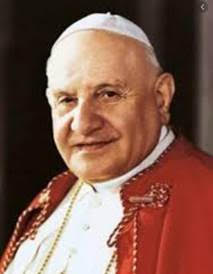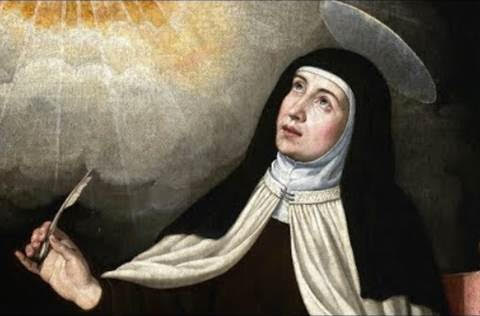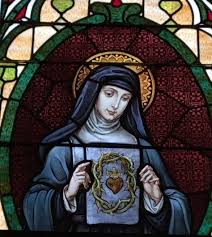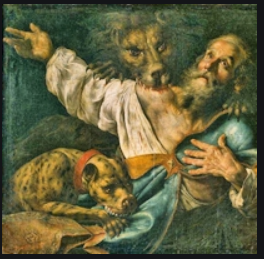Saints Featured for October 11, 2020 Lesson
The Church Has Heroes Too! Another fun thing to learn about as a Catholic is our friends, the saints. They may have lived in a different time, and some of these saints had a very difficult life, but all tried to live their life for God. It is helpful to spend some time learning about other human beings so that we might learn how to love God more. At the end of every story there is a question to help us learn from these Church heroes.

Pope Saint John XXIII Of course, John XXIII was not the name he was born with. His parents named him Angelo—Angelo Roncalli, born in 1881 in the northern part of Italy. His family farmed for a living, and Angelo was the oldest boy of twelve brothers and sisters. When he was a teenager, Angelo decided he wanted to be a priest. He studied in the seminary, where he was most interested in the history of the church. After he was ordained a priest, Angelo expected nothing more out of the rest of his life than that of a normal parish priest back in the part of Italy where he’d grown up. It was what he knew and what he thought God was calling him to. But very soon, it became clear that God had other plans for Angelo.
Over the course of his career, Fr. Angelo held many jobs, some exciting, some difficult. He was a secretary to a bishop for 10 years. He served as a medical worker in battlefields during World War I, and he never forgot the suffering he witnessed there. He represented the church in countries like Bulgaria and Turkey, countries where there were hardly any Catholics, and it was really important to understand and get along with people of different religions.
Finally, when he was 71 years old, Fr. Angelo Roncalli came home. He was appointed to be the leader of the church in the city of Venice, Italy. Fr. Angelo—now archbishop—had come home and, for all he knew, would spend the rest of his life simply tending to the needs of the people of Venice. But once again, God had something else in mind. In 1958, Pope Pius XII died, and, as always happens when a pope dies, all the cardinals of the church gathered to elect a replacement. Much to everyone’s surprise, they elected Angelo Roncalli of Venice. He was seventy-six years old.
Now, you would think that a seventy-six-year-old man would know his place. You’d think he would settle into the Vatican, sit comfortably in his chair, and just hold the fort until God called him home and a younger, more energetic man could get things going. When John XXIII was elected pope, the world was a very different place than it had been even 200 years before. In the past, the church had a lot of power in the world. That wasn’t the case anymore. Nations had much more power than the church and were sometimes using that power to hurt people. John believed that the church needed to speak with a stronger voice so that it could protect all people from war, violence, and poverty.
Other things had changed, too. There were new ways of thinking about the world, ways that had nothing to do with religion or the Bible. Many people had come to believe that the advances of science made faith in God unnecessary. John saw much good in new scientific discoveries, but he also knew that without God we are lost. He wanted to help people who had faith learn how to talk to people who did not have faith in ways they could understand and in ways that would help everyone see the truth of God’s love.
In other words, what John XXIII wanted was to open the church up to the world so that the church could spread the good news of Jesus’ love in a way that made sense to people of the new century. It wasn’t the Middle Ages anymore. It was the twentieth century. John wanted the whole world to be able to hear the Good News in twentieth-century words. John XXIII had a vision and hope. He made a decision based on that hope and based on the virtue of prudence, a virtue that he spoke of a great deal. John—whom today we call Saint John XXIII—believed that Jesus’ love was for everybody in the world. He wanted the church to be a strong voice proclaiming that love in modern times to modern people. He looked to the past, present, and future in making his decision to lead the church in that direction. God can use us no matter what our age. How do you listen to the voice of God? Loyola Press

St. Teresa of Avila Teresa was born in 1515 in Ávila. She proved at an early age that she was an intelligent and thoughtful person. Teresa and her brother, Rodrigo, didn’t play the same games that the other children played. Instead, they preferred to go to the garden and read. They were most interested in reading the Bible and the stories of the lives of the saints. They were most fascinated by the stories of the saints. The idea of sainthood fascinated them. To them it seemed that the saints would be in the presence of God forever. In their childlike way, they would run around the garden chanting, “forever, forever, forever.”
When she was 16, Teresa was sent to a convent to live, and at 21 she decided to become a nun. She enjoyed her life there and began to realize that she had been given a special gift. She was able to see heavenly visions. She chronicled these visions in her writing. One such vision came in the form of an angel who appeared to Teresa bearing a long golden spear. The angel was smiling and gentle so he did not frighten Teresa. The angel thrust the spear into Teresa’s heart. Instead of feeling pain, Teresa felt safe and at peace. The spear was not really a spear, but the love of God. When the vision passed, Teresa felt very close to God.
Teresa did many great things. She knew how to pray and many people wanted to learn from her. She wrote books to help them, which people still read today. She founded a convent, St. Joseph’s, whose focus was a simple life of prayer. Other religious orders opposed her and made her life hard, but eventually her ideas spread through Spain and into other parts of Europe. She was the foundress of the order know as the Discalced Carmelites.
She died in 1582 at the age of 67 and was made a saint in 1622. In 1970, she was named a Doctor of the Church for her writing and teaching on prayer. This was a great honor, especially for a woman of her time. Saint Teresa is the patron saint of persons who suffer from headaches.
St. Teresa liked to read stories from the Bible. Like her, read something from the Bible today. RCL Benziger

St. Margaret Mary Alacoque Her gift of mystical prayer enabled her to experience union with God and to make this union the focus of her life. This call to total dedication finally led her to enter the Visitation Monastery in Paray-le-Monial, France, on June 20, 1671 shortly before her 24th birthday.
From 1673 to 1675 Christ appeared to her showing her His Heart. “My divine Heart”, He said during the first revelation, “is so passionately fond of the human race, and of you in particular, that it cannot keep back the pent-up flames of its burning charity any longer. They must burst out through you.” He mourned the world’s indifference, coldness and thanklessness and asked Margaret Mary for a communion of reparation on the First Friday of each month. These apparitions became known when Saint la Colombiere died; his notes revealed the details of her revelations which she had written down at his request.
During her second term as assistant Superior, her health broke down, “Nothing serious: said her doctor but Margaret disagreed: “I shall not live for I have nothing left to suffer. I need nothing but God and to lose myself in the Heart of Jesus.” Seconds later, this confidante of the Sacred Heart and “heiress of all its treasures” (Jesus’ words) died October 17, 1690 at age 41. She was canonized in 1920.
The Bible tells us about Jesus’ great love for us. During the death of Jesus, His Heart was pierced with a soldier’s lance. Take some time to thank Jesus for His love and to tell Him that you love Him.
Live the Sacred Heart of Jesus

St. Ignatius of Antioch Born in Syria, Ignatius converted to Christianity and eventually became bishop of Antioch. In the year 107, Emperor Trajan visited Antioch and forced the Christians there to choose between death and apostasy. Ignatius would not deny Christ and thus was condemned to be put to death in Rome.
Ignatius is well known for the seven letters he wrote on the long journey from Antioch to Rome. Five of these letters are to churches in Asia Minor; they urge the Christians there to remain faithful to God and to obey their superiors. He warns them against heretical doctrines, providing them with the solid truths of the Christian faith.
The sixth letter was to Polycarp, bishop of Smyrna, who was later martyred for the faith. The final letter begs the Christians in Rome not to try to stop his martyrdom. “The only thing I ask of you is to allow me to offer the libation of my blood to God. I am the wheat of the Lord; may I be ground by the teeth of the beasts to become the immaculate bread of Christ.” Ignatius bravely met the lions in the Circus Maximus.
Like St. Paul, St. Ignatius of Antioch wrote letters to the believers in Rome. See if you can find St. Paul’s letter to the Romans in your Bible. Franciscan Media
More Saint Information
Read more about popular saints from Catholic Online.
You might want to incorporate a coloring page. Saint Coloring Pages for Kids
Optional activities and resources that compliment this lesson can be found on the links below.
God’s Word
Featured Saints
Family Activities
Additional Videos and Resources
Lesson Theme